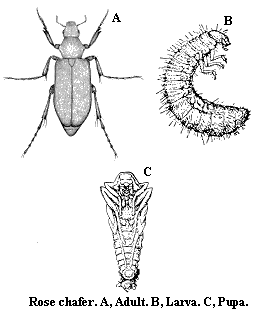|
 |
|
 |
|
 |
 |
This beetle is about a
half an inch in length and straw colored. As the season
continues, they become more mottled in color. The adults
emerge from the ground just as the grapes begin to
bloom. As the name implies, they also like to chew on
rose flowers and leaves.
  Rose
chafers tend to prefer sandy soils for laying their
eggs. The larvae are one of the many species of white
grubs that have 3 pairs of legs at the head end of the
body. To tell them apart from other white grubs such as
those of Japanese
beetles or
European
chafers, you need to take a look at the tiny hairs
called rastars found at the bottom of the grub's body.
Charts showing the differences are available if you have
the interest...and the time. Rose
chafers tend to prefer sandy soils for laying their
eggs. The larvae are one of the many species of white
grubs that have 3 pairs of legs at the head end of the
body. To tell them apart from other white grubs such as
those of Japanese
beetles or
European
chafers, you need to take a look at the tiny hairs
called rastars found at the bottom of the grub's body.
Charts showing the differences are available if you have
the interest...and the time.
|
 |
|
 |
 |
Rose chafers attack
many different plants in addition to
roses. They
will feed and produce a
skeletonized effect on the leaves, flowers, buds
and fruit of many species including grape, rose,
strawberry, peach, cherry, apple, raspberry,
blackberry, clover, hollyhock, corn, bean, beet,
pepper, cabbage, peony and many more.
|
 |
 |
 |
|
|
 |
 |
 |
There are several
approaches to managing rose chafers in the home
landscape: 1. Treat the
Adults - Rose chafers adults emerge from the ground in
about May most years so keep an eye out for them if you
have had problems in the past years. Once you see them
feeding, you may choose to spray with a labeled
insecticide. 2. Traps -
Traps similar or identical to those touted for Japanese
beetles are sometimes recommended for rose chafer too.
These are generally ineffective and may actually attract
more beetles into your garden. Avoid using traps for
these beetles unless you can place them at least 100
feet away from the plants you are trying to save.
3. Treat the Larvae - Again, as with other types of
beetles that spend part of their life cycle as grubs,
soil insecticide treatments may be affective. However,
the problem with treating rose chafers in this manner is
that they have the ability to fly quite well. The
(generally sandy soil) areas where the grubs are living
may be some distance from your property.
To be sure that the grubs are originating from your
property, you would need to dig some up and get someone
(perhaps your local
Extension
Service office) to identify them properly before you
start spreading soil
insecticides around.
|
|
 |
|
Note: We
have provided some general information and
observations on this topic aimed at the home
gardener. Before you take
any serious action in your landscape, check
with your state's land grant university's
Cooperative
Extension
Service for the most current,
appropriate, localized recommendations. |
|
 |
|



